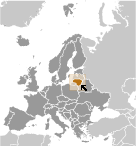World Atlas: Lithuania. On this page you can see the map, country flag and many detailed information about the people, history and economy of Lithuania.

Here you can find online selected information about the geography, inhabitants, government, economy and history of Lithuania. Included are selected statistics, an overview map and the detailed map of Lithuania. But let's start with the flag of Lithuania here:
Lithuania - Overview:
What you should know about Lithuania? Let's start with this: Lithuanian lands were united under Mindaugas in 1236; over the next century, through alliances and conquest, Lithuania extended its territory to include most of present-day Belarus and Ukraine. By the end of the 14th century Lithuania was the largest state in Europe. An alliance with Poland in 1386 led the two countries into a union through the person of a common ruler. In 1569, Lithuania and Poland formally united into a single dual state, the Polish-Lithuanian Commonwealth. This entity survived until 1795 when its remnants were partitioned by surrounding countries. Lithuania regained its independence following World War I but was annexed by the USSR in 1940 - an action never recognized by the US and many other countries. On 11 March 1990, Lithuania became the first of the Soviet republics to declare its independence, but Moscow did not recognize this proclamation until September of 1991 (following the abortive coup in Moscow). The last Russian troops withdrew in 1993. Lithuania subsequently restructured its economy for integration into Western European institutions; it joined both NATO and the EU in the spring of 2004. In 2015, Lithuania joined the euro zone.
Geography of Lithuania
 Where on the globe is Lithuania? The location of this country is Eastern Europe, bordering the Baltic Sea, between Latvia and Russia, west of Belarus. Total area of Lithuania is 65,300 sq km, of which 62,680 sq km is land. So this is not a large country. How could we describe the terrain of the country? This way: lowland, many scattered small lakes, fertile soil. The lowest point of Lithuania is Baltic Sea 0 m, the highest point Aukstojas 294 m. And the climate is transitional, between maritime and continental; wet, moderate winters and summers.
Where on the globe is Lithuania? The location of this country is Eastern Europe, bordering the Baltic Sea, between Latvia and Russia, west of Belarus. Total area of Lithuania is 65,300 sq km, of which 62,680 sq km is land. So this is not a large country. How could we describe the terrain of the country? This way: lowland, many scattered small lakes, fertile soil. The lowest point of Lithuania is Baltic Sea 0 m, the highest point Aukstojas 294 m. And the climate is transitional, between maritime and continental; wet, moderate winters and summers.
Inhabitants of Lithuania
Let's take a look how many people live in Lithuania. The number is: 2,823,859 (July 2017 est.). So this is not very populous country. Who lives here? Lithuanian 84.1%, Polish 6.6%, Russian 5.8%, Belarusian 1.2%, other 1.1%, unspecified 1.2% (2011 est.). What are the languages in Lithuania? Lithuanian (official) 82%, Russian 8%, Polish 5.6%, other 0.9%, unspecified 3.5% (2011 est.). And the religions: Roman Catholic 77.2%, Russian Orthodox 4.1%, Old Believer 0.8%, Evangelical Lutheran 0.6%, Evangelical Reformist 0.2%, other (including Sunni Muslim, Jewish, Greek Catholic, and Karaite) 0.8%, none 6.1%, unspecified 10.1% (2011 est.). How old are the people in average? 43.7 years. We have to add that this number is the median - so one half of the people is older than this, one half is younger. And what is their life expectancy (at birth)? This: 75 years. Where the people live in Lithuania? Here: fairly even population distribution throughout the country, but somewhat greater concentrations in the southern cities of Vilnius and Kaunas, and the western port of Klaipeda. The major urban areas of Lithuania are: Vilnius (capital) 517,000 (2015).
Government and Economy of Lithuania
The capital of Lithuania is Vilnius and the government type semi-presidential republic. Let's take a look at the administrative divisions - 60 municipalities (savivaldybe, singular - savivaldybe); Akmene, Alytaus Miestas, Alytus, Anksciai, Birstono, Birzai, Druskininkai, Elektrenai, Ignalina, Jonava, Joniskis, Jurbarkas, Kaisiadorys, Kalvarijos, Kauno Miestas, Kaunas, Kazlu Rudos, Kedainiai, Kelme, Klaipedos Miestas, Klaipeda, Kretinga, Kupiskis, Lazdijai, Marijampole, Mazeikiai, Moletai, Neringa, Pagegiai, Pakruojis, Palangos Miestas, Panevezio Miestas, Panevezys, Pasvalys, Plunge, Prienai, Radviliskis, Raseiniai, Rietavo, Rokiskis, Sakiai, Salcininkai, Siauliu Miestas, Siauliai, Silale, Silute, Sirvintos, Skuodas, Svencionys, Taurage, Telsiai, Trakai, Ukmerge, Utena, Varena, Vilkaviskis, Vilniaus Miestas, Vilnius, Visaginas, Zarasai. Regarding the economy of Lithuania, important industrial products are metal-cutting machine tools, electric motors, televisions, refrigerators and freezers, petroleum refining, shipbuilding (small ships), furniture, textiles, food processing, fertilizer, agricultural machinery, optical equipment, lasers, electronic components, computers, amber jewelry, information technology, video game development, app/software development, biotechnology. Important agricultural products are grain, potatoes, sugar beets, flax, vegetables; beef, milk, eggs, pork, cheese; fish. The most important export commodities are refined fuel, machinery and equipment, chemicals, textiles, foodstuffs, plastics and the most important export partners are Russia 13.5%, Latvia 9.9%, Poland 9.1%, Germany 7.7%, Estonia 5.3%, US 5.2%, Sweden 4.8%, UK 4.3% (2016). The most important import commodities are oil, natural gas, machinery and equipment, transport equipment, chemicals, textiles and clothing, metals and the most important import partners are Russia 14.4%, Germany 12.1%, Poland 10.8%, Latvia 8%, Italy 5.4%, Netherlands 4.8%, Sweden 4.4% (2016). How rich is Lithuania and how rich are people in this country? The most important number here is GDP per capita (PPP): $31,900 (2017 est.). This means the living standards are good here. Let's add that this means Gross Domestic Product per person, which is recalculated with respect to the relative cost of local goods and services. And one more important number - population below poverty line: 22.2% (2015 est.).